
Original Link: https://www.anandtech.com/show/2450
Power Supply Roundup: 650W-680W
by Christoph Katzer on February 21, 2008 2:00 AM EST- Posted in
- Cases/Cooling/PSUs
Introduction
Previously, we've reviewed many power supplies rated at 800W - more than even many high-end setups require. Today we want to look at a selection of more reasonable power supplies rated at ~650W, and our next roundup will have six power supplies in the 600W power range today. This range of power supply is in high demand in the market, as this tends to be where quality reaches an acceptable level without costing the proverbial arm and leg. It also helps that marketing recommends at least 600W for many "average" gaming PCs these days, so often users think they need this much power inside of their rig. The enthusiasts have moved on to designs that are even more powerful, leaving these PSUs for the mainstream markets.
As in all our reviews, we conduct our tests with a Chroma test setup, which is currently one of the most advanced setups in the market for testing power supplies.
Note: If you would like to know more about our testing methodology, equipment, and environment, please read our PSU testing overview.
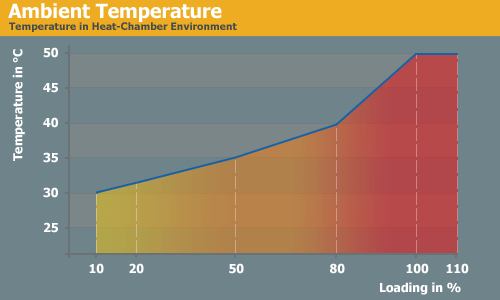
We now test with an additional 10% load beyond the rated output to see how the units cope with overload situations. We begin overload testing at room temperature, and if everything checks out we move on to our stress testing "heat chamber" that tops out at 50°C. Experience indicates that while many units can stand the overload testing at room temperature, others will have difficulty with the higher temperature and overload combined. Only the top units will survive this torture test.
Antec NeoPower 650 Blue
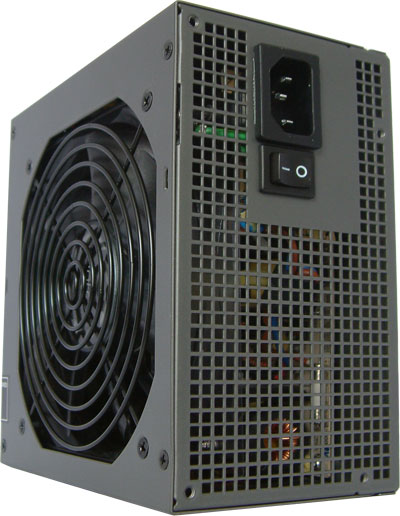
The NeoPower 650 Blue is a new entrant in the market that hasn't received much attention until now. It comes in a dark anthracite color called Gunmetal Black. The NeoPower 650 Blue appearance is typical of Antec PSU, with little to set it apart from other models. It has a 120mm fan on the bottom of the power supply that blows at the heatsinks inside. The back features square-shaped holes over the majority of the surface. The PSU comes in Antec's standard package with a paper shell to protect the power supply.
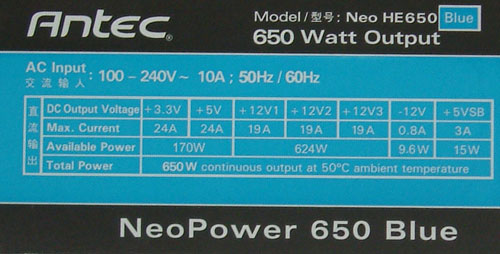
Like other power supplies from Antec, the NeoPower comes with three 12V rails rated at 19A. The total combined power of the rails is 624W, which is normal for a 650W power supply, and the 3.3V and 5V combined power is 170W. In fact, all the other power supplies today have the exact same combined power rating.

The NeoPower 650 Blue comes with a partial cable management system, allowing the user to disconnect several cables. The jacks on the PSU are a 6-pin design, which has proven effective with other models and manufacturers. With cable management, it is crucial to have a good connection between the cables and the power supply in order to avoid increasing the resistance.
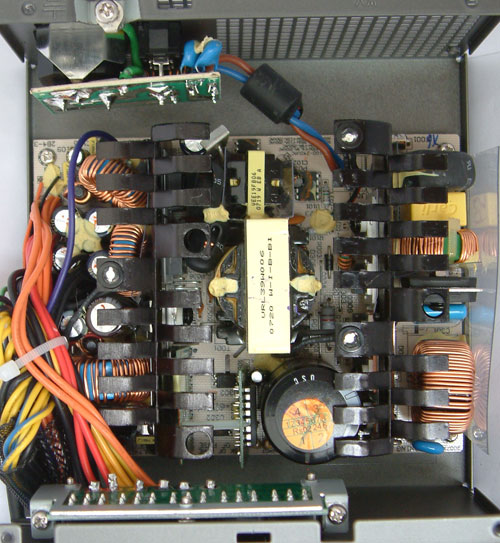
Opening this unit shows a design we've seen quite a few times now. You can see several small holes in the heatsinks, three of which hold the blue LEDs. These LEDs light up when the system is in operation, illuminating the PSU and case interior. The two heatsinks look quite tiny, but with good designs and a moderate 650W rating there is no need for bulky heatsinks. Later we will see that this unit has a high level of efficiency, which leaves less heat to dissipate. While the Seasonic design and layout have been around a while, they still do quite well. As competition heats up, we expect to see some new designs, but there is no need yet. As the saying goes, if it's not broken, don't fix it.
Be
quiet! Dark power PRO P7 650W
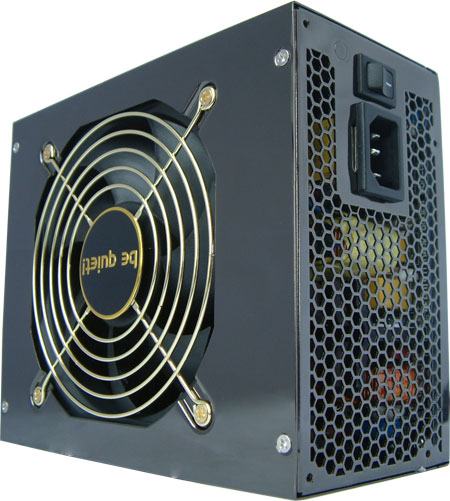
be quiet! (Ed: yes, the lowercase and exclamation point are the correct way to spell the name) is a brand most of our readers likely have not encountered. The company is in Germany, where their largest customer base is located, and we first mentioned be quiet! in our power supply summary in December 2007. be quiet! offers unique service to its customers. If a power supply experiences any malfunction, they will send someone to collect the power supply and deliver a brand new one within 48 hours. The company offers this service in France and Poland as well, but unfortunately they are not shipping units to the US and thus that level of support is not available.
Their power supplies all have a similar look, with a dark glossy appearance. The P7 series is the seventh model of the existing Dark Power PRO series that first came to market around 2002. The power supply comes in a nice finish and a golden fan grill. Note that the 180mm housing is quite long and will cause incompatibilities with some smaller cases.
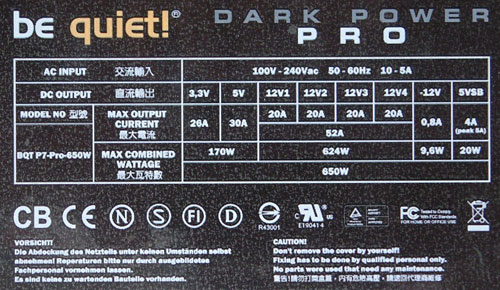
The be quiet! Dark Power PRO comes with four 12V rails rated at 20A. The total combined power however remains the same as other units today: up to 52A or 624W. The 3.3V rail is rated at 26A and the 5V rail at 30A. Together they can pull up to 170W, which is an average load. Keep in mind that most systems will rarely require more than a couple hundred watts of power, unless you are running multiple graphics cards with a heavily overclocked CPU.
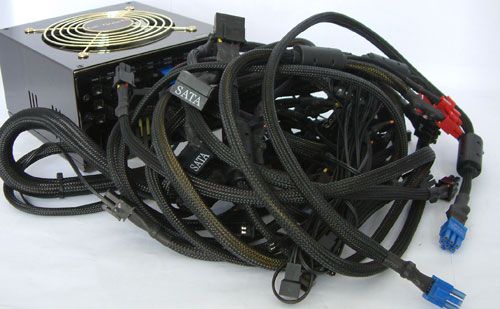
The Dark Power PRO comes with lots of cables, giving the user a variety of options. With a minimum length of over 60cm, even users with larger cases should not have any difficulties getting the cables to all the required areas. All the cables are sleeved in black all the way to the connectors, completely obscuring any view of the cables. Noteworthy features include the four harnesses that each have a 3-pin and a 4-pin Molex connector, which users can connect to case fans and allow the power supply to control fan speeds.
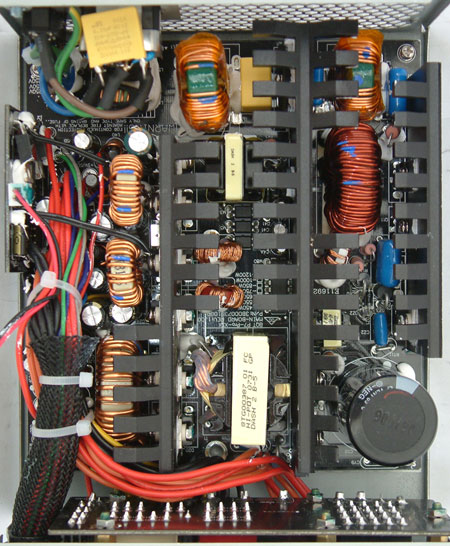
Opening this very long power supply, we find three long and thin heatsinks. The fins have a decent separation, which is good for airflow to the PCB components. be quiet! doesn't appear to waste much space in this long housing, but it is actually used for all their models from 450W up to 1200W. Even with a smaller 650W rating, the PCB is full of components. Since the manufacturer uses this chassis for their whole range of PSUs, the length makes some sense even if it's not really necessary. It's a matter of optimizing certain manufacturing and cost aspects, leaving them free to focus on other areas like quality. Still, the question of case incompatibility remains, and it's difficult to imagine someone purchasing a 450W PSU with the intention of buying a full-size ATX case.
Hiper Type-R MKII HPU-5B680
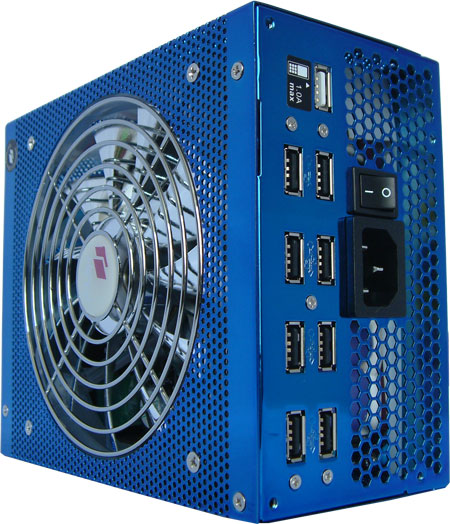
We already reviewed several Hiper power supplies in previous roundups, and today we will be looking at the HPU-5B680. It comes in a shiny blue color, and much of the casing exterior has many small punched holes. According to Hiper these help with cooling, though we've seen opinions elsewhere that these holes will do the opposite and instead disrupt airflow. During our testing, we couldn't really see any good or bad aspects to the holes. The cooling is similar to other CWT-based designs: not really better but definitely not worse. Hiper uses a single large 135mm fan on the bottom to provide cooling, which is silver to match the overall look.
The USB ports on the back of the power supply are a nice touch if you seem to run out of ports. However, most PCs today have enough USB ports for all sorts of applications, and not many people will need eight additional ports (which are actually part of a single USB hub). The one white port does supply power even when the PC is off, and with a maximum 1A users can use it to recharge MP3 players as an example. Even though we can't really say who would need it, but in a crowded market anything that sets your offerings apart from competitors can help.
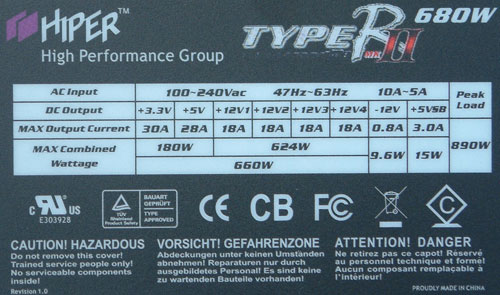
The 680W unit has four 12V rails rated at 18A, once again with a combined power of 624W. The lower voltage 3.3V and 5V rails have a combined power of 180W, typical of today's offerings.
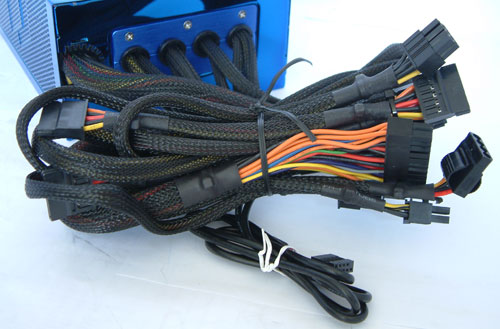
All of the cable harnesses leave the PSU chassis in a slightly different manner than what most are used to seeing. Instead of using a single round exit with a huge cluster of cables, Hiper uses five holes spread across the front, with two harnesses in each one. Hiper says this gives users better access to the cables with the PSU mounted in a case. Hiper does not provide a large number of cable harnesses, instead choosing to provide Y-splitters that attach to the cables connectors. This gives users a better choice of where to put the connectors, which is a good thing. The downside is the added resistance created by the extra connection, even if it's just a very small one not recognizable by most users. For lower wattages, the amount of current coming through these connections isn't that much, so the resistance shouldn't be a problem. However, we wouldn't recommend this type of approach on a 1200W model.
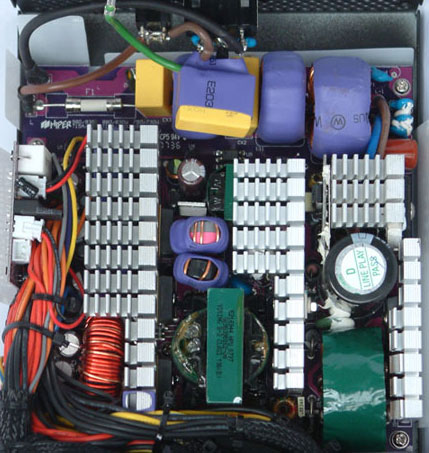
Once we open the housing, the ODM is easily recognizable. This is the first unit of this roundup manufactured by Channel Well, and we'll see two more later. Compared to the units we've seen so far, we see small changes component-wise and different heatsinks. Hiper actually has their own assembly line for their products at the manufacturer's facility. We visited one of Hiper's production facilities in China just after CES this year, and Hiper has a major role in the production and conducts all the quality control.
Seasonic
Energy Plus SS-650HT
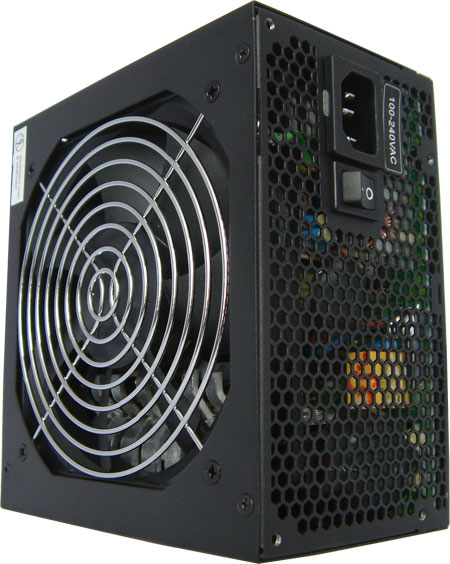
As one of the pioneers of the modern "planet saving movement", Seasonic's 650HT is a very aged power supply. Still, as stated Seasonic was one of the first companies to design energy efficient topologies, and they've earned respect from users all over the world. Coming in a standard black color with a silver fan grill, this unit doesn't look all that special, but that's Seasonic's modus operandi, and it has helped make them famous. Their first retail power supply - the Super Tornado in 2002 - came in plain grey in a day when colorful power supplies were all the rage. Seasonic ignored the fads and instead focused on high efficiency and high reliability for their products. The 650HT was one such product, first released a few years ago. Since many own these power supplies (or variations of this power supply), we felt including it in this roundup made sense.
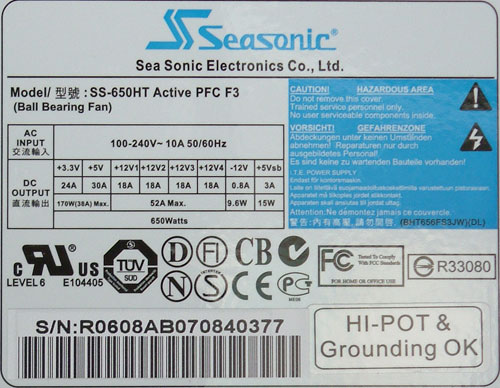
Looking at the Seasonic label we see four 12V rails rated at 18A, with a total combined power of 52A. Recognize the pattern yet? The 3.3V and 5V rails both have the standard amperage and 170W combined power.
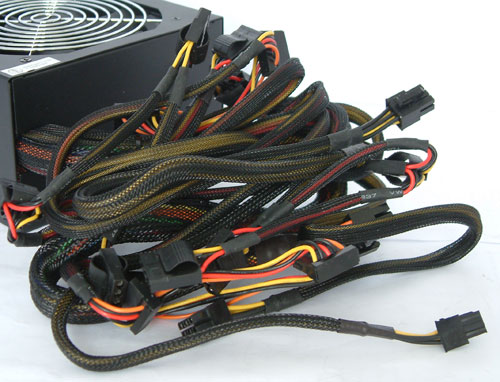
Being a little bit behind the current market trends has been a common feature of Seasonic, but since this fellow is already over a year old we won't criticize it for only including two 6-pin PEG connectors; besides, that's standard practice in the 650W range as we can see from the competition today. All cables are nicely sleeved with a decent length. Seasonic doesn't try to be different from the crowd, and the cables come with standard lengths of at least 50cm.
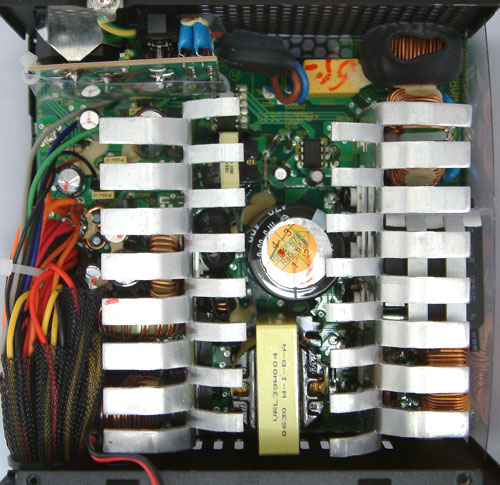
The inside is nice and sleek. Compared to the be quiet! power supply, the Seasonic Energy Plus seems empty and comes in a very short and compact case. Look closer and you can see that this design is also used in the PC Power & Cooling Silencer, though PC Power added components to the primary side. Seasonic also uses a 120mm fan, which is the major difference from some of their OEMs. The heatsinks need to let some air through, and Seasonic uses a standard heatsink design of a simple plate cut and bent into shape. It's one of the cheapest methods of producing heatsinks since the tooling costs of an extruded heatsinks are quite high, but Seasonic doesn't have a problem with high temperatures and this type of heatsink is sufficient for their needs. Channel Well also uses this method for some of their power supplies, but they don't leave enough space between the fins to let air through.
Thermaltake Toughpower QFan 650W
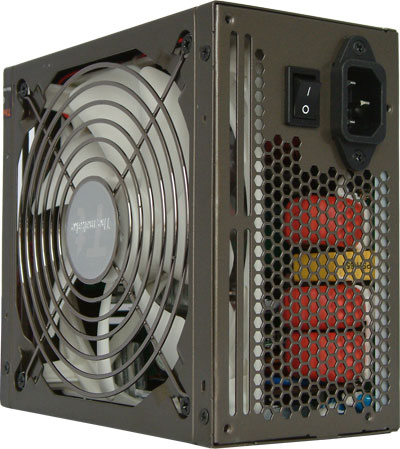
Thermaltake enters the fray with a new feature called QFan. This means the frame is practically left open and the power supply casing has also long punched holes on the sides around the fan. This allows the fan to suck in additional air and - according to Thermaltake - it reduces turbulence and noise. The housing comes in a brown-grayish color that fits nicely with the red Thermaltake highlights we often see on their cases. The packaging is durable and keeps the power supply protected during transport.
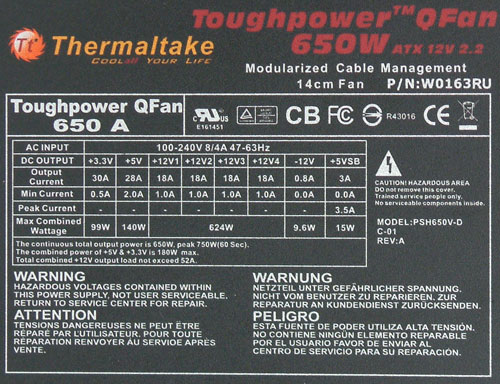
The label looks pretty much like all the others: four separated 12V rails at 18A and a combined power of 624W. The combined power for the lower voltage rails isn't mentioned; only their highest output is written on the label. We'd like to have specific details from Thermaltake, but it's not too much of a stretch to assume that the combined power is going to be similar to the 170W we see on all the other units today.
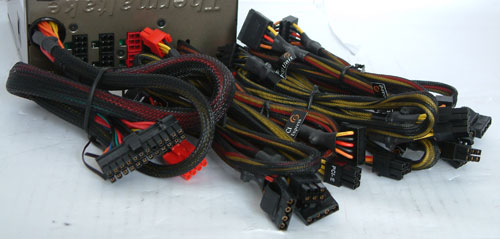
The cables are stored in a quality bag, which is a nice addition. All cables are sleeved up to the first connector. The chassis connection jacks are 6-pin designs, which have proven to be very stable. There are sufficient cables and connectors to provide power to most midrange to moderate high-end systems.
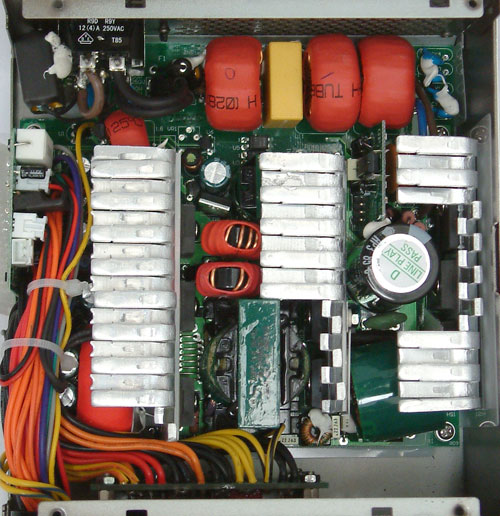
The inside looks an awful lot like two other power supplies we're reviewing today, and in fact we have seen this design a lot lately. It seems that 40% of the high-end market comes via CWT (Channel Well Technology) these days. Thermaltake was actually one of the first with this design, and many others followed. That said, being manufactured by the same company doesn't mean these power supplies are all the same. There are still many differences in terms of component choice and heatsink designs, and this will be reflected in our graphs later - the differences are quite noticeable. What we never liked with this particular design is the heatsinks - they simply don't make much sense. They are made of an aluminum plate punched into the right shape, which is not unusual, as it's an inexpensive way to make a heatsink. The problem with Thermaltake's approach is that there are no gaps to pass air through, so the heatsinks function like an umbrella not letting any air go through to the components under the heatsink. Seasonic is also making their heatsinks in the same way but they at least have enough space in between the fins for the air to pass by. The chosen components are mostly high quality such as the Hitachi capacitor sitting on the primary side and the secondary side is equipped with Samxon capacitors, but the heatsinks are still far bulkier than necessary.
Xigmatek NRP MC651
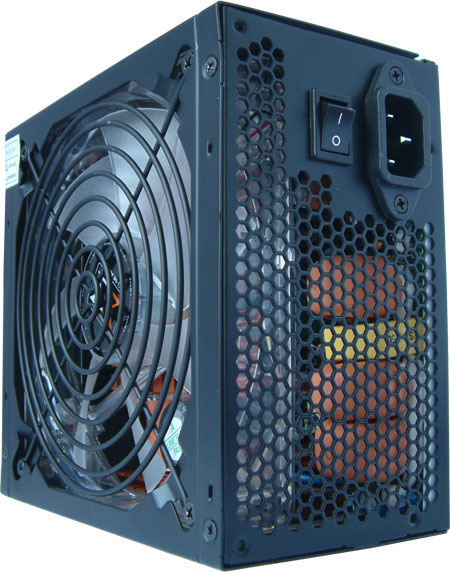
Xigmatek is a newer brand and is only sporadically available in the US at present. Xigmatek began a few years ago with very promising cooler designs and they have now jumped on the bandwagon of high-margin PSUs. We received our sample a while ago (before the unit began shipping), so we don't have any retail packaging. The unit design is final, however, and it looks quite nice. The housing is black as is the grille, and the fan is transparent. You can find the real manufacturer listed on the front of the unit, but Xigmatek took the liberty of using different colored cable sheathes and shrinking hoses.
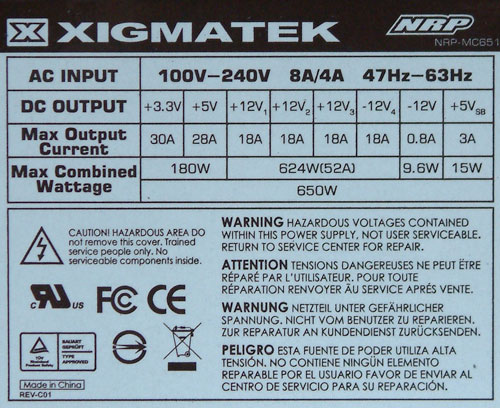
In terms of power ratings, we have a table nearly identical to all the other units. There are four separate 12V rails with a total combined power of 624W. The 3.3V and 5.0V rails have a combined power of 180W - slightly higher than the other units, though not particularly meaningful.
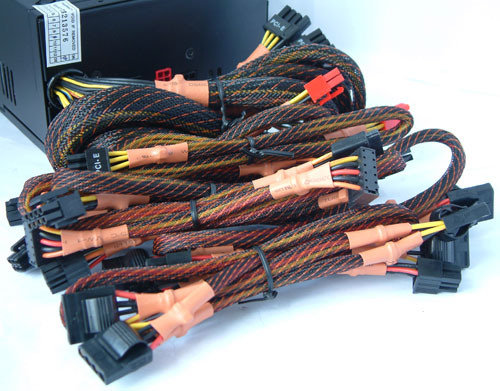
Xigmatek also uses 6-pin connectors for their cable management and provides four PEG cable harnesses, two with one 6-pin PEG and two with one 6/8-pin PEG connector. The two 6/8-pin PEG connectors connect to the main harness through the little hole on the front of the casing. The red jacks are for the additional two 6-pin PEG connectors if you need them for an SLI/CrossFire setup. With up to four PEG connectors, Xigmatek definitely gives users the best choice for graphics cards in today's lineup.
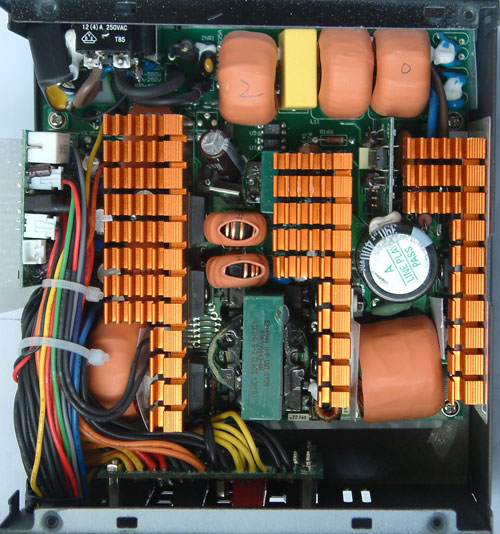
Opening the unit clearly reveals that Channel Well is the ODM. We have seen so many CWT power supplies lately that it's getting a bit tiresome. However, Xigmatek made some minor changes so they at least give this power supply something of a personal touch. All shrinking hoses and heatsinks are orange/beige, and you get an attractive "No Rules Power" plaque on the side (that's the NRP in the name). The results will show in a moment that performance is similar to the Thermaltake, which is no surprise considering it has the same components such as the Hitachi main-cap. For the secondary side Xigmatek went for Nippon Chemi-Con caps, which are a better choice.
Comparison: Cable Length
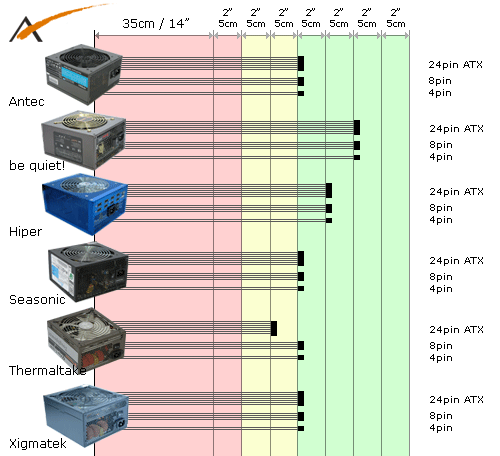
The comparison of cables shows an average of 50cm (20"). Hiper added 2" and be quiet! yet another 2". The majority of the manufacturers stick with 50cm, which is sufficient for most cases. Of course, other factors such as whether you have a top-mounted or bottom-mounted PSU can impact your cable length requirements. Many cases have space near the PSU up top where you can easily tuck away any unused or overly long cables, and this can be important since long cables can disturb and cooling if you're not careful. Those who have cases where the PSU mount on the bottom will likely want longer cables, however, as reaching all the way to the optical drives and motherboard connections can be something of a stretch. All the power supplies feature a 4-pin and 8-pin ATX/EPS plug to supply the CPU with additional power.
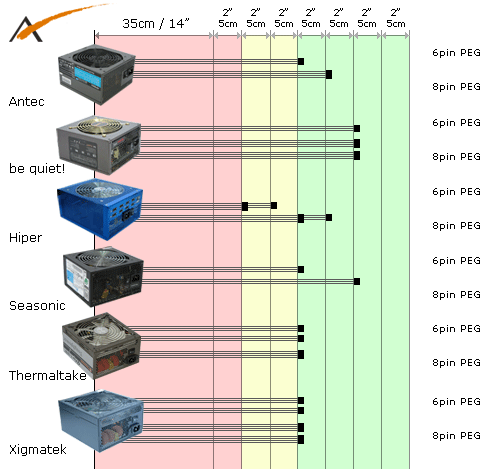
Looking at the PEG connectors, we see major differences between the power supplies. Antec comes with one 6-pin and one 6/8-pin connector, which is sufficient for an SLI/CF setup so long as the graphics cards have require one 6-pin jack each. Alternately, you could use both connectors for one graphics card if the 8-pin connector is needed (i.e. Radeon HD 2900XT).
Be quiet! provides two 6/8-pin PEG connectors and an additional 6-pin EPS connector needed on special motherboards. The length is 60cm/24", which is the longest offering in our roundup today. Hiper takes a different approach and attaches two connectors to each harness. Users get one 6-pin and one 6/8-pin connector (6-pin with two extra pins to convert it to an 8-pin PEG connector) on each of the two harnesses, which is enough to support even a high-end SLI/CF setup.
We mentioned Seasonic already and have to point out that the power supply has been in the market for quite some time, so it's not really up-to-date anymore. It only features two 6-pin PEG connectors, which is fine provided you don't intend to buy any HD 2900 XT cards with an 8-pin jack on it (to date the only GPU that requires an 8-pin connector, though that will probably change in time). Thermaltake offers two 6-pin connectors and one 8-pin connector.
Xigmatek has the best offering, providing two 6-ping and two 6/8-pin PEG connectors. The cable length of 50cm/18" is fine for most cases available. We have to give Xigmatek credit for offering more connectors with a 650W power supply than others. While there are higher-rated PSUs out there that offer many connections, the fact is that a good quality 650W PSU (Ed: not just any old 650W PSU!) is more than enough to run most high-end systems; only systems with numerous hard drives, serious overclocking, and Tri-SLI are likely to break into wattages above 650W.
Comparison: DC Output Stability
Stable voltage output is what power supplies are designed to provide. They need to deliver the proper voltage to components so that they can function correctly. The higher the load gets, the more difficult it is for a power supply to deliver the desired voltage; this results in a constant voltage drop with increasing current. With the following graphs, we want to show the stability of these rails during operation. We show the range in which a power supply is able to provide the correct voltage. For these charts, we take the average deviation of all the measured results. The lower results indicate better compliance to regulations - i.e. less over- or undervolting on the rails - which means the PSU is better.
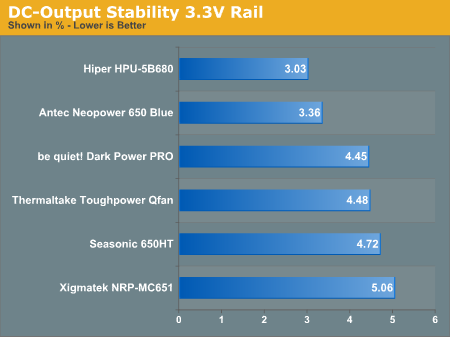
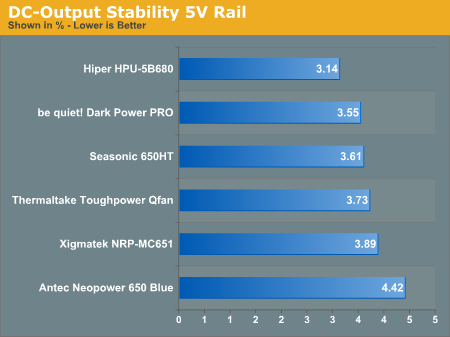
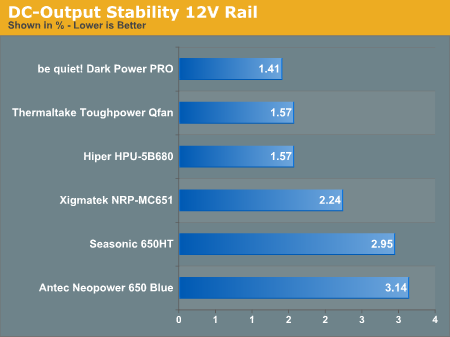
The unit from Hiper shows very good results, taking first place on the lower voltage rails. The deviation here is about 3%, which is very good and stable score. The other units aren't much worse, but they're still not as close to spec as the Hiper unit. With the 12V rails, things are slightly different. Here we have three power supplies rising above the rest. The units from be quiet!, Thermaltake, and Hiper are all within 1.57% of spec. In general, the regulation on the 12V rails runs much tighter with all of the units.
Comparison: Efficiency and Acoustics
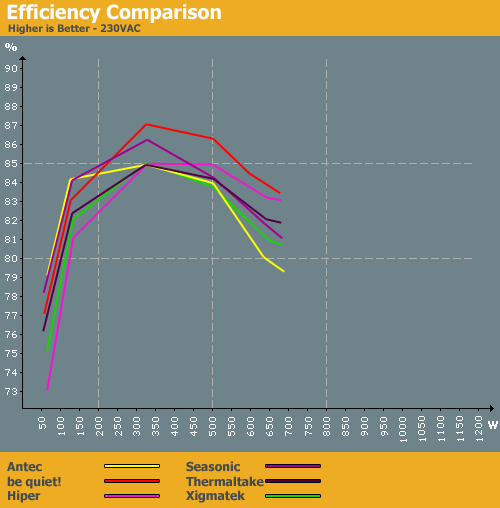
The efficiency chart shows good results for all the contenders. Since all the power supplies in this roundup have the same wattage, we can easily compare the results. Seasonic and be quiet! stick out from the group, both with efficiency higher than 85%. However, we can also see that these power supplies should run at more than 100W in order to achieve maximum efficiency. Antec also does well with over 84% efficiency from 150W to 500W.
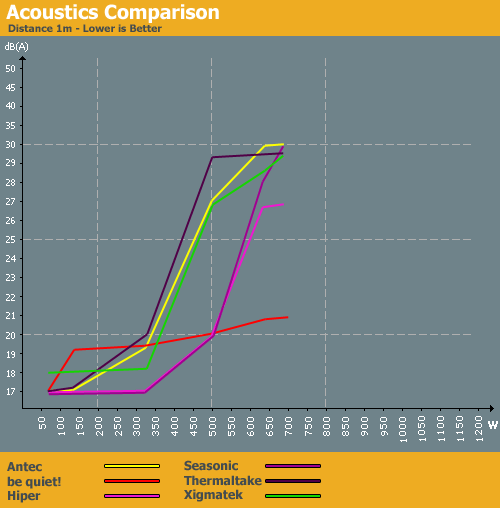
The acoustic comparison doesn't show any major differences between the power supplies at lower output levels - levels that most systems will use. Hiper and Seasonic seem to have a similar fan control unit and fan as the noise levels are almost identical; likewise the Antec, Thermaltake, and Xigmatek units are all very close together. All of the units are near-silent up to ~300W, beyond which we see many scale rapidly in fan speed and noise levels.
The Seasonic and Hiper are the two best units up to 500W, as they stay under 20dB(A) throughout the range. Probably more impressive, however, is the be quiet! unit, which reaches a maximum 21dB(A) even at the full 650W output. be quiet! is famous in Germany for their low noise power supplies, and deservedly so. However, there's a tradeoff taking place: the lower noise levels are accompanied by higher temperatures, and running for prolonged periods of time at maximum load could cause problems. Then again, that's what the warranty is for, right? The be quiet! Dark Power PRO is not audible under most loads, which our graphic clearly shows. A constant noise level of 19 to 21dB(A) is definitely the best result we have seen so far. The other power supplies reach noise levels of up to 30dB(A), and while that may be noisier than some would like the lower temperatures are certainly not a bad thing.
Prices and Final Thoughts
This roundup shows that many power supplies within this wattage range are some of the best overall choices; users can get very good quality for a reasonable price. Most users don't need even 650W, but it's more difficult to find good quality PSUs in the 300-500W range, and here at least there's plenty of room for future expansion - most SLI/CF configurations will work great on these 650W units. All of the tested units also provide enough connectors to support such setups. While all of these power supplies are good, a few models stand out in certain areas.
Hiper and Xigmatek both provide four PEG connectors, which is enough to support all but the highest-end SLI/CrossFire setups. Running dual 8800 GTX/Ultra or HD 2900 XT cards won't leave much room for other areas, so if you're looking to run an overclocked quad-core CPU along with four or more hard drives you would almost certainly want to move beyond 650W PSUs. However, for stock performance the Hiper and Xigmatek can handle just about any CPU/GPU configuration currently on the market.
The efficiency rating of all the power supplies is also very good, peaking at 85% or more. be quiet! tops the list with up to 87% efficiency and Seasonic comes next with 86% - impressive considering Seasonic has been selling this unit for over a year. All the other power supplies are only fractionally behind, however, offering 84% efficiency up to 500W load.
In terms of noise levels, the be quiet! unit actually manages to live up to its name. At a maximum of only 21dB(A), this power supply is not audible and even with full load and you need to get very close to the fan to hear it. The fan speed is about 500RPM, which is definitely slow and helps to keep noise down, but it also results in less air moving through the power supply. Hiper and Seasonic also perform well with only 20dB(A) as long as they stay under 500W of load. The others are all above 25dB(A) from 500W onwards, but they stay below 30dB(A) and are still quiet enough for all but the most demanding Silent PC users.
The build quality is excellent with all the power supplies we looked at today. We didn't find any flaws during operation and none of the units went up in flames. (Ed: Drat!) When we consider the fact that these are all moderately expensive PSUs and three are manufactured by the same ODM, however, this is not a surprising result. Many users would be well served by a power supply from this wattage range, provided you don't skimp on the price. You get decent quality capacitors and other components, and the results speak for themselves. The prices are higher than many other lower quality products, but when you consider how much money is spent on CPUs, GPUs, RAM, and other areas, it hardly makes sense to save a few dollars on the component that makes everything actually function.
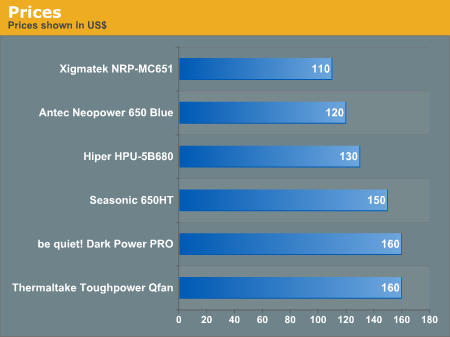
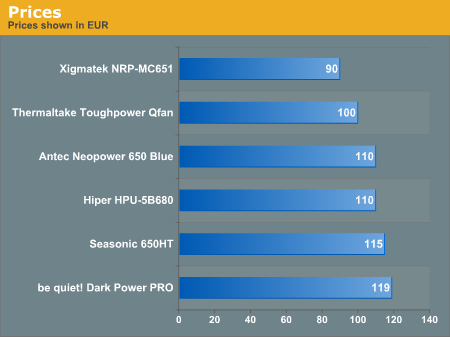
In Europe, the prices are all quite similar, differing only by a few Euros. It's strange to see the Thermaltake Toughpower Qfan for around 100 EUR - the cheapest in Europe - but it's $160 in the US, which is the most expensive option. While none of the power supplies are bad, a few look to be better than the rest. The Hiper and Xigmatek offerings provide a great balance of price, features, and performance, whether in Europe or the US. Thermaltake is also worth a shot in Europe, given it's 10 EUR cheaper in some areas, and Antec warrants a look in the US at $120. The be quiet! Dark Power PRO ends up as the most expensive unit in the US and Europe, but at the same time there are users that will pay the money for silence.
Our overall recommendation remains with the Hiper HPU-5B680 and Xigmatek NRP-MC651. Both performed very well throughout testing, no doubt helped by the high quality components such as Hitachi and Nippon Chemi-Con capacitors. Choosing between these two options in the US will come down to personal preference - slightly lower noise (Hiper) or a better price (Xigmatek).







